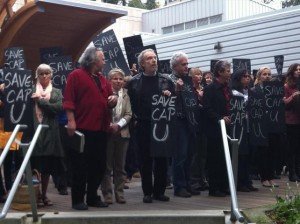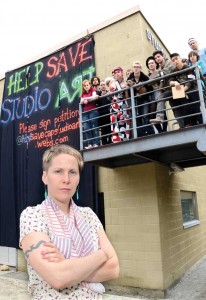Cindy Oliver, CAUT Bulletin, January 2014– English Language Training (ELT) programs play an increasingly critical role in Canada’s post-secondary institutions as the diversity and complexity of our student population changes, and with it, the need to address those changes with programs that strengthen language proficiency. Although post-secondary education is primarily a provincial responsibility, the federal government plays a crucial role in the funding of ELT programs across the country. And it’s the looming cuts to the federal government’s contribution to those programs that has united British Columbia’s student organizations and the Federation of Post-Secondary Educators to pressure governments to take a different approach.
It was no coincidence the press conference was held at the Vancouver campus of VCC; it is the largest provider of ELT programs in western Canada. It’s a role that VCC has excelled at for more than 40 years. And it has become something of a professional hub for a growing number of international students who have come to Canada to begin a new life, but need to strengthen their English language skills to ensure they can fully participate in their new country.
On hand for the press conference was Saeideh Ghassarifar, a foreign trained doctor who enrolled at VCC after immigrating to Canada from Iran. During media interviews, Ghassarifar pointed out she has an extensive educational background in her chosen field — she has three degrees, including a PhD in health care education — but she recognizes that her English language skills need to be much stronger. As she said in one interview, “as a doctor I need to understand and be understood when I am dealing with patients.” For her, the VCC English language programs are critical to her ultimate success in this country.
However, the very programs Ghassarifar accesses at VCC are under threat if the federal government moves ahead with its plans to withdraw funding currently in place under a long-standing federal-provincial settlement services agreement. It is through that agreement that BC receives close to $20 million in federal funding that eventually works its way into ELT programs at institutions like VCC. The change to the settlement program in BC, if it goes ahead as announced, would take effect on April 1, 2014.
The federal government’s rationale for cutting the funding makes no sense. Prime Minister Stephen Harper’s austerity rhetoric has permeated every aspect of life in Canada, from oversight of the environment to the muzzling of federal government researchers and scientists. In every case, Harper’s approach has been to diminish the capacity of government to provide information and services that would fulfill the federal government’s part of the social contract with Canadians, a contract that should respect our rights as citizens while ensuring sustainable and balanced growth is shared. During his tenure as Prime Minister we have seen no evidence that he intends to keep up his side of the contract.
Just as troubling, however, is that Harper’s reneging on the $20 million in funding for BC programs comes at a time when the provincial government’s commitment to post-secondary education has come under enormous pressure. For most of the past 12 years, core funding of BC’s public institutions, like in many other provinces, has simply not kept pace with the demands of increased enrolment or system-wide cost pressures. Add in the fact that government policy shifts that have allowed tuition fees to skyrocket over that same period — in BC the average undergraduate tuition fee has more than doubled — and the pressures on access and affordability have simply added more barriers to the education that government, business leaders and the broader community all know are critical to our collective success as both a province and a country. Notably, the BC Business Council — hardly a left-wing think tank — has pointed out on numerous occasions that 75 per cent of all new jobs in BC will require some form of post-secondary education (a degree, diploma, certificate or completed apprenticeship). The council notes that currently only two-thirds of BC’s labour force has that education.
The cuts in funding for English language programs are a step backwards. They will hurt students, the very people that BC and Canada need to support and encourage. Our campaign will focus on their stories and highlight the urgent need to keep ELT funding in place. Working together with allies and the broader community we are confident we can make a difference.
Cindy Oliver is president of the Federation of Post-Secondary Educators of BC.

 Follow
Follow


